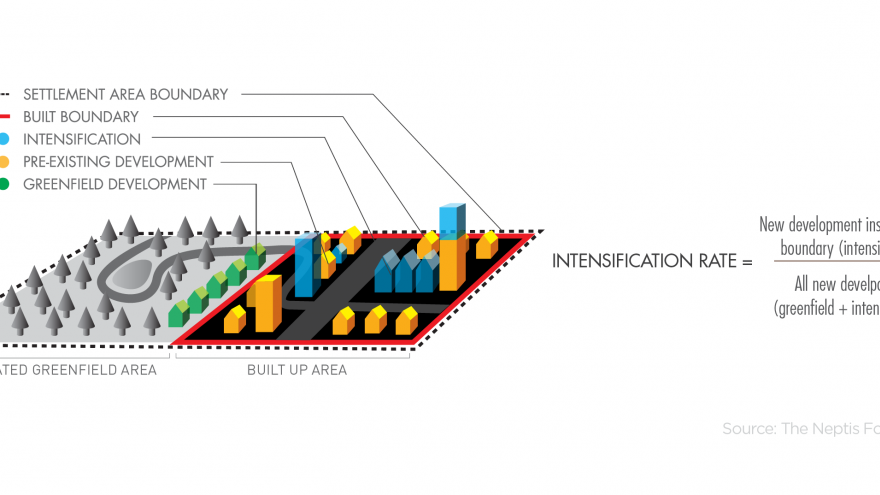Last week, the Ontario Growth Secretariat (OGS) wrapped up the last of the four public consultation meetings on a set of proposed Performance Indicators that will be used to assess the effectiveness of the Growth Plan for the Greater Horseshoe. The Secretariat is seeking feedback on the breadth, relevance and value of these indicators and the sources of data used to measure them.
The meeting I attended last Thursday was a full house of engaged and thoughtful professionals from many sectors. Larry Clay, Assistant Deputy Minister at the OGS, expressed surprise at the amount of interest in a subject as seemingly dry as performance indicators. The enthusiasm was rightly attributed to a committed and motivated community of planners and the public.
The indicators cover a variety of themes--change in urban form, travel patterns, employment (specifically office employment), and land conservation. Some indicators measure outcomes more directly than others.
The OGS had strived to select indicators drawn from data that are available region-wide. The criteria immediately point to a number of traditional data sources--Statistics Canada, Canadian Housing and Mortgage Corporation, Ontario Parcel database and the Municipal Property Assessment Corporation.
What the province has not done is create a reporting system that will allow it to access the best information available, currently housed within municipalities.
As someone who has worked for the last 15 years at stitching together data sets to form a regional picture of Toronto, I am well aware that the traditional sources have their limitations, as noted in the OGS's Technical Report. Although these sources can help indicate how change is occurring in our region, there is a limit to how often these indicators can be measured and how detailed a picture they paint.
The first question the OGS should be asking is: what is the objective of this exercise? Is it a one-time measurement that will provide information internally to the OGS as it prepares for the mandated 10-year review of the Growth Plan? Or might this exercise be seen as an opportunity to rally support and further buy-in to the Growth Plan through the development of a knowledge base on how our region is growing and changing within the framework of the Growth Plan?
There was certainly support for the latter perspective among the stakeholders at last Thursday's meeting. In particular, municipal stakeholders appeared open to sharing the data they have gathered in the process of bringing their planning documents into conformity with the Growth Plan.
Such willingness to share data seems unprecedented and may help to overcome the wariness among some municipalities that the indicators will be used to compare one municipality against another. Indeed, there was general consensus that the Province should go even further in developing a program that better defines and supports the role of municipalities in building this knowledge base for our region, a role that the Growth Plan already contemplates (Section 5.4.3.3) but the Performance Indicators Discussion Paper does not specify.
When the OGS provided an overview of the Performance Indictors to the Neptis Foundation in early March, we asked why the Province hadn't asked municipalities for the data they needed. We were told: 1) the OGS couldn't possibly request data from the municipalities; 2) municipal data would not be comparable across the region; and 3) not all municipalities collect data.
During the consultations, the OGS must have been surprised to learn that most municipalities were willing to share their data. As part of conforming to the Growth Plan, municipalities have had to get a better understanding of where growth is occurring and internally have developed sophisticated data analysis techniques to track development.
There is an old adage in the field of geographic information systems that says the best data is the closest source of data. Certainly the municipalities are better suited to track what is happening on the ground, where, and in what form, compared with federal agencies such as the Canadian Mortgage and Housing Corporation or Statistics Canada. Furthermore, municipalities are starting to appreciate the value of open data and many have gone to great lengths to provide their data to the public.
It is true that municipalities take different approaches to data collection, but Neptis's recent exercise of developing a spatial data set of the urban and rural settlement area in the region shows that these obstacles can be overcome.
Another point of consensus was that not all performance indicators need to be measured for all municipalities. There is significant diversity in the region, and the Plan recognizes that diversity. For example, measuring the range of land uses, one of the proposed indicators, may not be as meaningful in rural municipalities as it would be in Mississauga, so it may not be all that important if rural municipalities do not have the data to measure this particular indicator.
With technology and the number of data sets being captured today, there are many opportunities for collaboration in building a regional knowledge base that measures how our region competes on the global stage.
The question remains: will the OGS and its associated ministries seize this opportunity to create an innovative and potentially groundbreaking open data initiative as they develop the performance indicators program and go beyond a numbers exercise?


